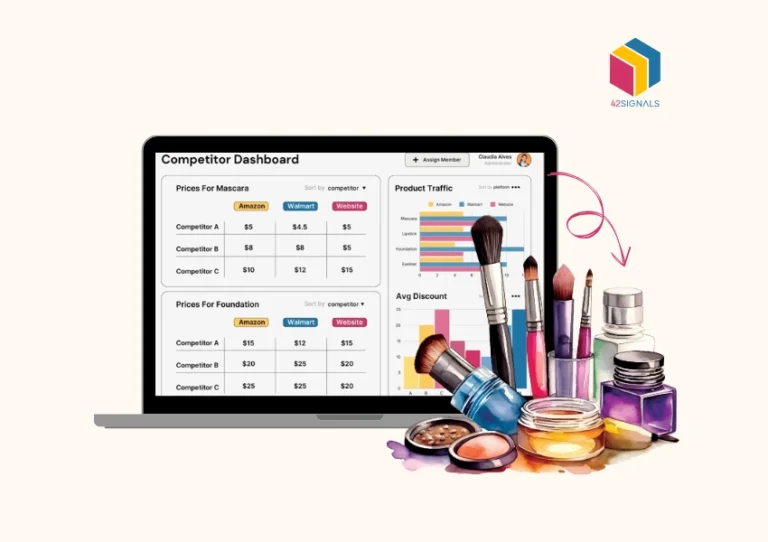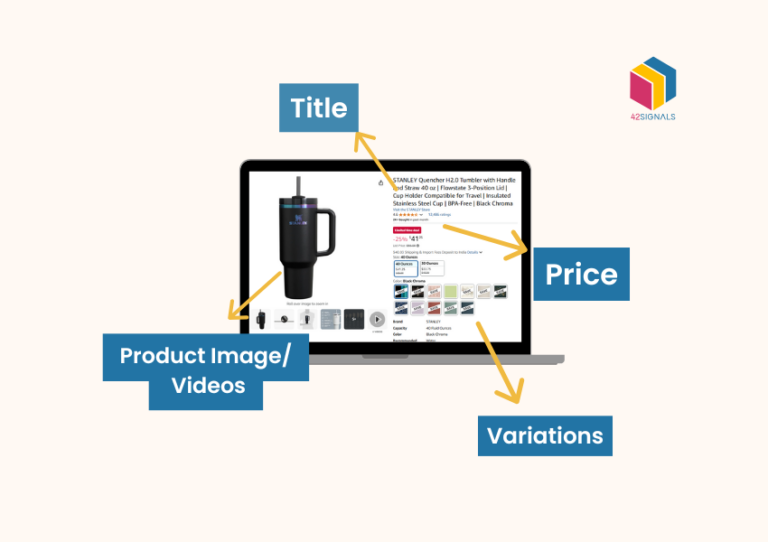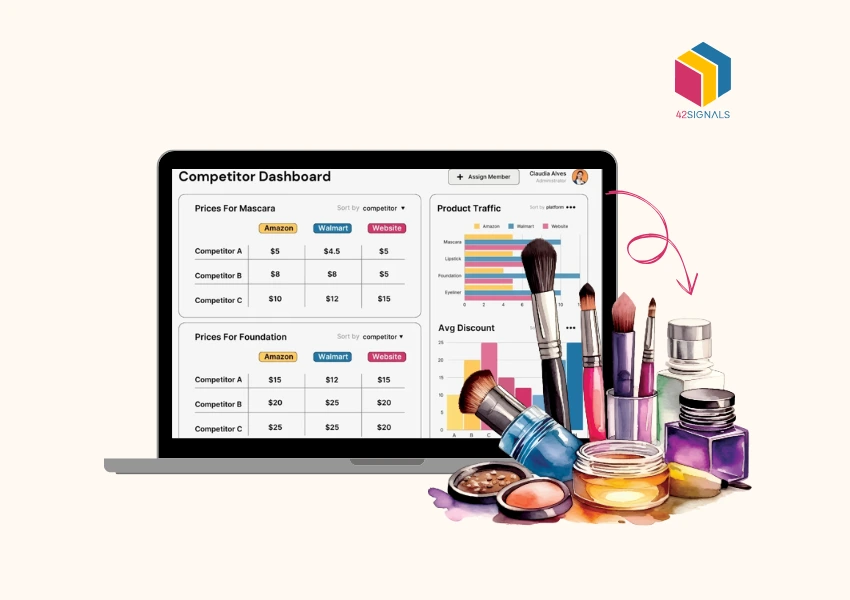In 2025, manual competitor tracking will be as dead as fax machines. The brands winning today aren’t just watching rivals—they’re using AI-powered competitor tracking tools, price alerts, and competitor analysis dashboards to predict moves before they happen.
Imagine knowing your competitor will slash prices next Tuesday… on Friday. Or spotting a rival’s inventory glut and hijacking their traffic with a flash sale. It can easily happen with a cutting-edge competitor monitoring tool.
Here’s your step-by-step plan.
Step 1: Deploy AI-powered Competitor Monitoring Tools
Forget Google Alerts. 2025’s tools are like having a spy network on steroids.
The ECommerce Analytics Tool to Use
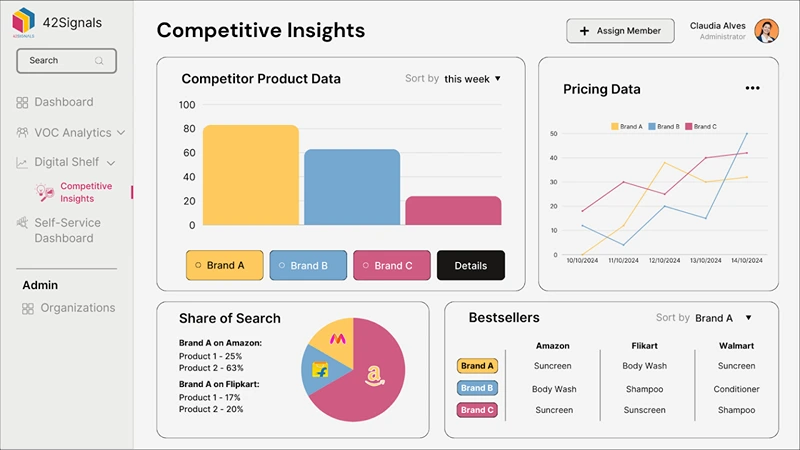
- 42Signals: Uses web scraping and AI to scrape competitor websites, ecommerce marketplaces, and even quick commerce applications to detect price changes, customer sentiment, and product information data. Some of the advanced features of the platform include –
- Quick commerce platform tracking – the ability to track products and competitors’ activities on quick commerce applications to improve sales and operations.
- Understand competitor trends, pricing strategies, and bestselling products to make prompt decisions.
- Learn about share of search on online marketplaces and make product and keyword changes quickly.
Case Study – The Sneaker Startup That Out-Niked Nike
A DTC brand used 42Signals to detect Nike’s supplier delays via shipping manifest leaks. They stockpiled inventory, launched a “Never Out of Stock” campaign, and stole 12% of Nike’s Amazon traffic during peak season.
Pro Tip
Set up “competitor cloning” in your dashboard. If Rival X’s drone starts ranking for “best gifts for teens,” auto-optimize your listings for the same keywords and undercut by 10%.
Step 2: Weaponize Real-Time Price Alerts
Price alerts in 2025 aren’t just notifications—they’re automated counterstrikes.
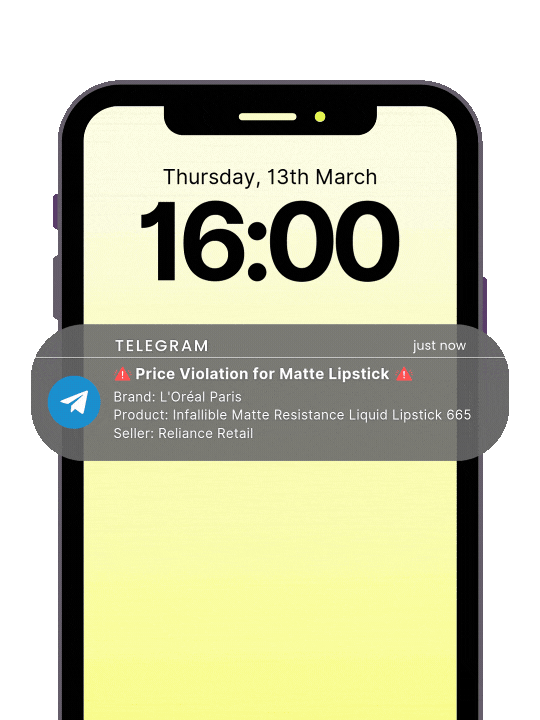
How to Set It Up
Choose Your Triggers
- MAP Violations: Get alerts when rivals dip below Minimum Advertised Price. Auto-report them to sellers to nip any violations that can devaluate your brand in the bud.
- Flash Sales: Tools like PriceYak 2.0 can trigger instant discounts on your end when competitors launch 24-hour deals. This means you stay competitive at all times and do not lose out of sales because of competitor discounts.
- Stock-Outs: When a rival’s inventory hits 10%, auto-raise your price by 5%. Customers looking to buy items immediately will pivot to your brand instead of waiting for a long wait time for the stock to come in.
Integrate with Repricers
- Tools like RepricerExpress AI adjust prices before competitors move.
Example: If Walmart’s price for “wireless earbuds” drops in Dallas, your repricer lowers prices in Dallas only—not globally.
Real-World Carnage
A kitchenware brand used alerts to spot a competitor’s Prime Day pricing error (199 instead of 299). They matched the “discount,” cleared $500K in sales, and let the rival bleed out.
Step 3: Build a Competitor Analysis Dashboard That Thinks
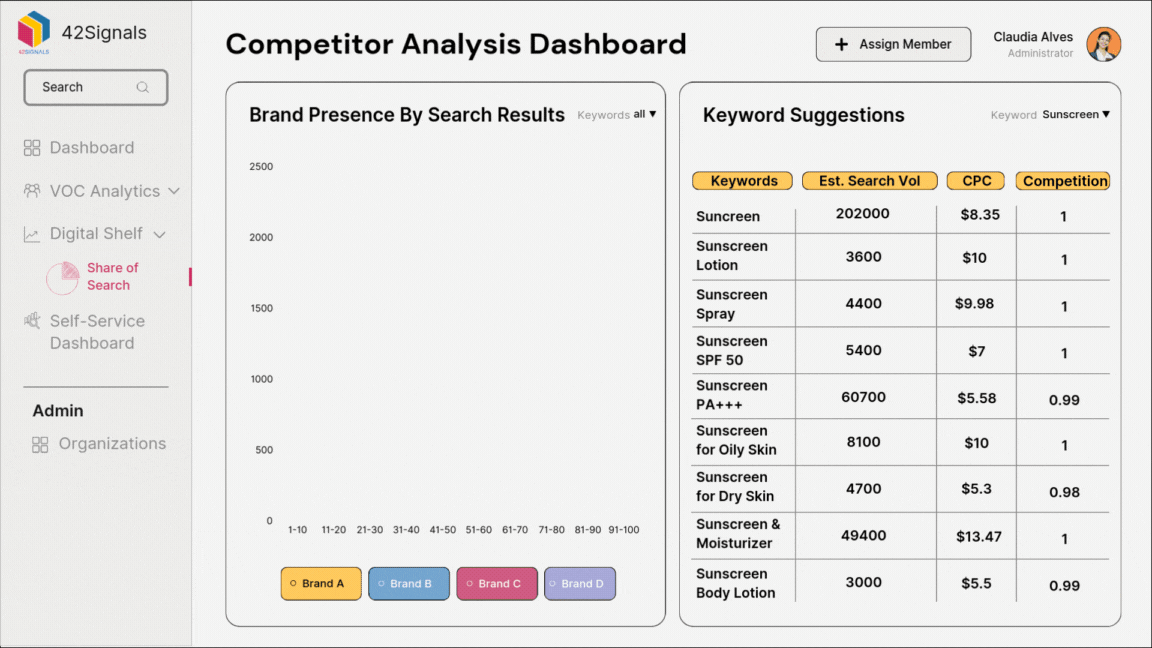
Your competitor analysis dashboard should be a War Room, not a spreadsheet.
2025’s Must-Have Competitor Monitor Features
- Unified Market Share View: See your slice of the pie vs. competitors in real time. This helps keep strategies proactive so quicker changes can be made in real time rather than seeing the advertised effects of competitor dominance over your products.
- Sentiment Heatmaps: Track spikes in negative reviews for rivals (e.g., “defective” mentions = launch a “Reliable Alternative” campaign). This allows for quick resolutions of smaller issues and proper consideration of larger issues that may require further testing and iterations.
- Predictive Battle Cards: AI-generated scripts for sales and marketing teams based on rivals’ weaknesses (e.g., “Competitor X’s shipping is slow—offer free 2-day delivery”). Keeping an ear to the ground on new marketing and promising strategies is a good way to avoid losing out on orders due to bad messaging.
Tools to Try
- Crayon 2025: Aggregates data from 50+ sources (even podcasts) to predict competitor R&D moves.
- SEMrush Apollo: Shows competitors’ hidden PPC tactics, like which keywords they’re A/B testing.
Pro Tip
Add a “Nuclear Button” to your dashboard. Example: One click deploys pre-made Amazon Sponsored Ads targeting a rival’s top keywords with a 50% discount promo.
Step 4: Master Digital Shelf Data for Stealth Dominance
Digital shelf data isn’t just about rankings; it’s also about owning every inch of the screen your customers see.
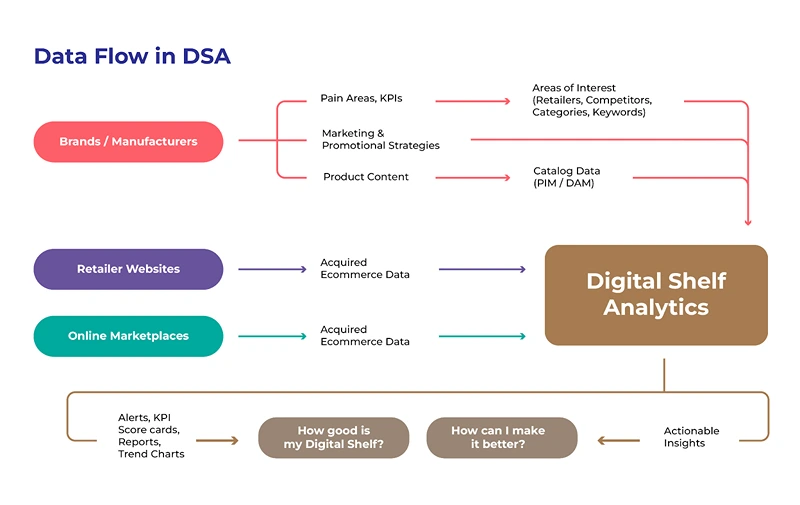
2025 Tactics
- AI-Generated Content: Tools like CopyGenius auto-rewrite product titles using top-performing keywords from competitors. You can also cross-reference this data with other platforms like 42Signals to see what keywords competitors are using and the gap that exists.
- Image Recognition Scans: VisualIQ analyzes rivals’ product images to suggest upgrades (e.g., “Add a size comparison chart—Competitor X’s customers complain about fit”).
- Review Hijacking: Use ReviewBolt to auto-respond to negative reviews on competitors’ pages with your product link. This may not be the ideal way to steal traffic but can be effective if you notice certain competitor products consistently getting bad reviews. Diverting them to your product page can give them a better solution to their problems.
Case Study – The Vitamin Brand That Poisoned Its Rival
A supplement company used digital shelf data to find a competitor’s collagen powder had “clumpy texture” complaints. They launched a “Silky Smooth Collagen” line, ran Sponsored Ads on the rival’s product page, and grabbed 18% market share in 60 days.
Step 5: Merge Ecommerce Analytics with Competitor Monitoring Data
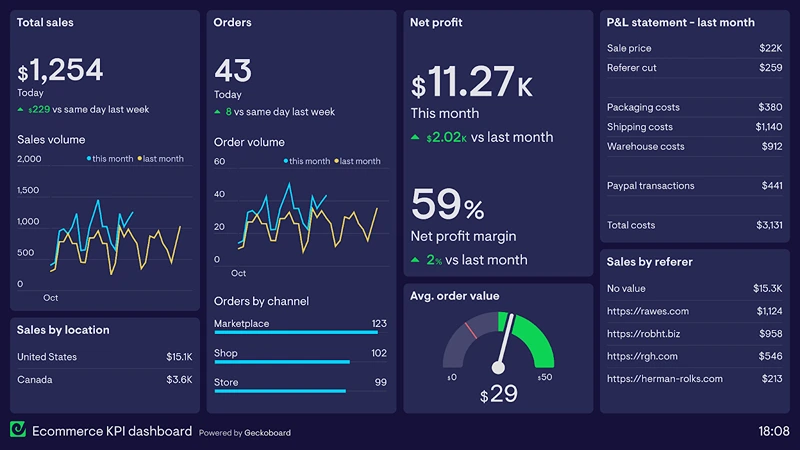
Image Source: Geckoboard
Ecommerce analytics in 2025 means connecting your data with competitors’ to see the full battlefield.
Actionable Integrations
- Cart Abandonment Cross-Analysis: Tools like SaleCycle show if customers abandon your cart to buy a cheaper rival product. Auto-send a discount code. This is crucial as the customer may have decided not to go ahead with the purchase due to a higher order or shipping costs. A discount code could then convince them to purchase as they were already interested in the brand and your products.
- Traffic Source Spying: Use SimilarWeb 2025 to see competitors’ top referral sites. Buy ads there first. A smart way to market and advertise as your brand show up exactly where your competitors are selling.
- Dynamic Bundling: If a competitor’s product is often bought with socks, bundle yours with free socks. You can also curate other bundled items to ensure that complementary items are coupled together. This is very useful when the customer doesn’t realize that they want an item, but seeing the bundle, could understand the benefit of purchasing both products.
Example
A skincare brand discovered via ecommerce analytics that 30% of their site visitors also checked a rival’s “retinol serum.” They created a “Retinol + Moisturizer” bundle and retargeted those visitors with a 20% off offer, stealing 25% of the rival’s sales.
The Dark Side: Ethical Lines You’ll Want to Cross (But Shouldn’t)
- AI Fake Reviews: Tools exist to generate fake 5-star reviews. Don’t. Amazon’s 2025 AI detects them in 0.2 seconds, and that’s not the road any brand should voluntarily take. Once fake reviews once spotted makes the customer completely mistrustful the brand, and this can lead to a snowball effect.
- Sabotage Bots: Some brands DDOS (Distributed Denial-of-Service where a DDoS attack means that an attacker floods a server with internet traffic to prevent users from accessing connected online services and sites) competitors’ sites during launches. Don’t. (But maybe run a stress test on your own site to prepare.
- Trademark Bidding: Bidding on “Nike Shoes” is allowed, but using their logo in your ad isn’t. This is obvious and something no brand should voluntarily do by infringing on another company’s copyright and trademark.
The Future: AI That Predicts Your Competitors’ 2026 Strategy
2025 is just the warm-up. In the upcoming years, competitor monitoring will become essential. Tools like 42Signals will help brands navigate the quickly developing ecommerce landscape with prompt and actionable insights.
To summarize –
- Brands selling digitally need ecommerce data readily and promptly to stay on top of micro and macro trends
- Manual monitoring is out of the door; ecommerce analytics tools are the future
- Looking at competitor intelligence, quick commerce data, Amazon, and other marketplace intelligence, businesses can make informed decisions on the fly
- Brands that leverage such tools stand to gain and take a large market share
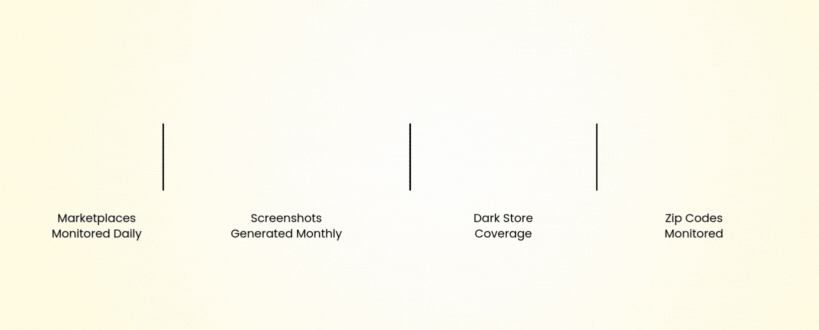
If you’re curious to know more about how this data can help an e-commerce business like yours, schedule a free demo with us, or alternatively, sign up for a free trial to see our easy-to-use platform in action today.

